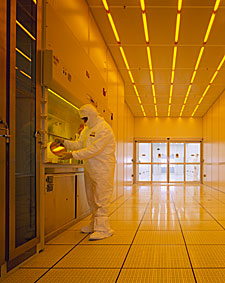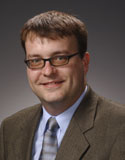|
June
16, 2005

[NIST
Tech Beat Search] [Credits] [NIST Tech Beat
Archives] [Media
Contacts] [Subscription Information]

New
Gene Chip May Be Early Cancer Diagnosis Tool
A
pilot study
at the National Institute of Standards and Technology (NIST),
in support of the National Cancer Institute's Early Detection
Research Network (EDRN), has validated the measurement accuracy
of new techniques that use mitochondrial DNA as an early indicator
for certain types of cancer. Additional results suggest that
a relatively simple diagnostic test using a DNA microarray “chip”
could enable early detection of some solid tumors, including
lung cancer.
Mitochondrial
DNA (mtDNA) plays a role in respiration and the cell’s
energy conversion mechanism. Since the late 1990s, researchers
at the Johns Hopkins University School of Medicine have observed
changes in mtDNA sequences in solid cancers, although the nature
of the relationship remains uncertain. Their work suggested
that particular changes in mtDNA might serve as early indicators
for several types of solid cancer. Although promising, this
approach is critically dependent on developing reliable, cost-effective,
and highly sensitive methods of analysis to detect the cancer
indicators against the background of natural variation in mtDNA.
The NIST
Cancer Biomarker Validation and Reference Laboratory assesses
cost, efficiency and reliability of potential diagnostic techniques
using biomarkers before further clinical evaluation in other
laboratories of the EDRN. The lab found that full mitochondrial
genome sequencing using capillary electrophoresis detected mtDNA
changes associated with early cancer. In ongoing work, NIST
is comparing capillary electrophoresis methods with a newly
developed DNA sequencing chip. The mtDNA chips are a promising
research tool for early clinical cancer diagnosis that may be
faster, easier to interpret, and provide higher throughput than
other methods. A paper describing the NCI-NIST work appears
in the May issue of the Journal of Molecular Diagnostics.*
Funded and coordinated by the National Cancer Institute to speed
the development of molecular, genetic and other biomarkers for
early cancer detection, the Early
Detection Research Network is a national network of research
institutions, including developmental labs, validation labs
and clinical centers. NIST is one of five reference and validation
labs in the EDRN.
*J.P. Jakupciak,
W.Wang, M.E. Markowitz, D. Ally, M. Coble, S. Srivastava, A.
Maitra, P.E. Barker, D. Sidransky, and C.D. O’Connell.
Mitochondrial DNA as a Cancer Biomarker. Journal of Molecular
Diagnostics 2005 7: 258-267.

Finding
the True Measure of Nanoscale 'Roughness'
 |
A new NIST/SEMATECH technique should help semiconductor
facilities improve measurement of the "linewidth
roughness."
Courtesy HDR Architecture, Inc./Steve Hall© Hedrich
Blessing
For a high-resolution version of this photo, contact inquiries@nist.gov.
|
Straight
edges, good. Wavy edges, bad. This simple description holds
true whether you are painting the living room or manufacturing
nanoscale circuit features.
In a technical
paper* published in June, researchers at the National Institute
of Standards and Technology (NIST) and SEMATECH describe an
improved method for determining nanoscale "linewidth
roughness," an important quality control factor in semiconductor
fabrication. Their research shows that current industry measurement
methods may be exaggerating roughness of the smoothest circuit
features by 40 percent or more above true values.
As circuit features
shrink in size to below 50 nanometers, wavy or rough edges
within semiconductor transistors may cause circuit current
losses or may prevent the devices from reliably turning on
and off with the same amount of voltage.
"With
this type of measurement," says NIST's John Villarrubia,
"besides the real roughness there is also a false roughness
caused by measurement noise. Our method includes a correction
to remove bias or systematic error from the measurement."
Random
noise, by definition, causes the measured value to be sometimes
higher, sometimes lower than the true value, and can be minimized
by simply averaging an adequate number of measurements. Systematic
error, however, is consistently above or consistently below
the true value due to some quirk of the measurement method.
The noise
in nanoscale scanning electron microscope (SEM) images consistently
adds extra roughness, says Villarrubia. The NIST/SEMATECH
method involves taking two or more images at exactly the same
location on a circuit feature, comparing the values, and subtracting
the false roughness caused by measurement noise. SEM manufacturers
should be able to incorporate the new method into their proprietary
software for automated linewidth roughness measurements.
* J.S.
Villarrubia and B.D. Bunday, Unbiased Estimation of Linewidth
Roughness, Proceedings of SPIE 5752 (2005) pp. 480-488.

Software
Advance Helps Computers Act Logically
Computers
just respond to commands, never “thinking” about
the consequences. A new software language, however, promises
to enable computers to reason much more precisely and thus better
reflect subtleties intended by commands of human operators.
Developed by National Institute of Standards and Technology
(NIST) researchers and colleagues in France, Germany, Japan
and the United Kingdom, the process specification language software,
known as ISO 18629, should make computers much more useful in
manufacturing.
ISO 18629
uses artificial intelligence (AI) and mathematical logic to
represent computer commands in the context of a manufacturing
plan. Researchers have incorporated approximately 300 concepts,
such as “duration” and “sequence,” into
its software structure. Computers using software with this expanded,
though still primitive AI capacity, can act on a word’s
“meaning,” interpreting a command almost like a
person.
For instance,
a person who hears the commands “paint it, before shipping
it” and “turn on the coolant, before milling”
understands that the word "before" has slightly different
meanings in these two different contexts. In the first command,
it is understood that painting and drying must be completed
prior to the next action, shipping. In the second command, however,
the first action, turning on the coolant, continues after the
milling starts. ISO 18629 supports computer systems with this
type of rudimentary understanding of context-specific language.
The ISO
18629 language is especially suited for the exchange of process
planning, validation, production scheduling and control information
for guiding manufacturing processes. The International Organization
for Standardization (ISO), which already has approved six sections
of the fledging standard, is currently reviewing the last of
its three sections. Once the expected ISO approval is given,
software vendors will begin building a variety of manufacturing
systems that conform to ISO 18629.
Media
Contact:
John
Blair, john.blair@nist.gov,
(301) 975-4261

New
NIST Method Improves Accuracy of Spectrometers
Measurements
of the intensity of light at different wavelengths can
be made more accurately now, thanks to a new, simple method
for correcting common instrument errors. The new method,
developed by researchers at the National Institute of
Standards and Technology (NIST), will benefit fields such
as color measurement, lighting development, remote sensing,
biotechnology and astronomy.
The
NIST method improves the measurement accuracy of spectrometers,
devices that measure optical radiation at different wavelengths.
Spectrometers are used widely in industrial settings and
academic research to analyze the emissions from lamps
or other light sources, as well as to analyze optical
properties of materials. The NIST method corrects errors
arising from the presence of stray light, unwanted scattered
radiation within an instrument.
Stray
light is often the major source of measurement uncertainty
for commonly used spectrometers. It can cause unexpectedly
large systematic errors, even as much as 100 percent depending
upon the application, when an instrument tries to measure
a very low level of radiation at some wavelength while
there are relatively high levels in other wavelength regions.
The new NIST method nearly eliminates stray light errors,
to a level less than 0.001 percent of the total signal,
a desirable level for most industrial and scientific applications.
This allows very accurate measurement of low-power components
of radiation and accurate measurements across a large
dynamic range of intensities.
NIST
researchers implemented and validated the method using
a commercial CCD-array spectrograph, which measures light
in the visible region instantly. They characterized the
response to monochromatic emissions from tunable lasers
that covered the instrument's full spectral range. Calculations
were made using the measured data to produce a matrix
that quantified the magnitude of the stray-light signal
for every element (or pixel) of the detector array for
every wavelength of light. The matrix then was used to
correct the instrument's output signals for stray light.
The method is simple and fast enough to be incorporated
into an instrument's software to perform real-time stray-light
corrections without much reduction in the instrument's
speed.
NIST
recently began offering a special calibration service to
characterize spectrometers for stray light using the new
method. Plans are being made to transfer the technique to
industry, and a technical paper is in preparation. For further
information about the calibration service, contact Yuqin
Zong at yzong@nist.gov, or (301) 975-2332.
Media
Contact:
Laura
Ost, laura.ost@nist.gov,
(301) 975-4034
Quick
Links
NIST
Researchers Receive Presidential Research Awards
 |
 |
| Michael
Fasolka |
Joel
Ullom |
The
White House announced on June 13 that two National
Institute of Standards and Technology (NIST)
researchers have been selected to receive 2004
Presidential Early Career Awards for Scientists
and Engineers, the nation's highest honor for
professionals at the outset of their independent
research careers. Michael J. Fasolka and Joel
Ullom of NIST were among 58 researchers honored
in a ceremony presided over by John H. Marburger
III, science advisor to the President and director
of the White House Office of Science and Technology
Policy.
Fasolka,
a materials scientist, was recognized for "experimental
and theoretical studies of nanostructured polymer
films and for investigations further extending
the power of next-generation scanned probe microscopy
techniques with exquisitely designed structures
providing quantitative measures of chemical,
mechanical, and optoelectronic nanoscale material
properties."
Ullom,
a physicist, was honored for "new insights
into quasiparticle dynamics in superconductors
and the physics governing noise in superconducting
phase transitions, and for his development of
improved superconducting sensors and the first
practical quantum solid-state refrigerator."
Established
in 1996, the awards honor the most promising
researchers in the nation within their fields.
Eight federal departments and agencies annually
nominate scientists and engineers at the start
of their independent careers whose work shows
exceptional promise for leadership at the frontiers
of scientific knowledge during the 21st century.
Participating agencies award these talented
scientists and engineers up to five years of
funding to further their research in support
of critical government missions.
For
further information, see www.ostp.gov/html/PECASE20046-13-05.pdf.


Flemming
Awards Received by Four NIST Researchers
On
June 6, four NIST researchers were among 12
honorees who received the Arthur S. Flemming
Award at a ceremony held at The George Washington
University in Washington, D.C. Established by
the Downtown Jaycees in 1948, the Flemming Awards
honor outstanding federal employees. Recognized
by the President of the United States, agency
heads, and the private sector, the winners are
selected from all areas of the federal service.
The awards are made in three categories—scientific,
program management and applied science.
In
the scientific category, Daniel Fischer was
cited for his pioneering work in developing
a critical facility for soft X-ray absorption
spectroscopy that has enabled key scientific
and technological advances in cutting-edge technology
and for his groundbreaking work on self-assembled
nanoparticles, nanotubes, biomaterials, and
high-temperature superconductors. Jun Ye was
honored in the same category for his contributions
to the fields of precision measurement, quantum
optics, ultrasensitive detection, and cold molecules
as well as his demonstration of a unified time
and frequency spectroscopy of atoms using phase-stabilized
femtosecond lasers.
Steven
Jefferts was recognized in the applied science
category for his outstanding efforts in both
the technical and managerial leadership of the
world's most accurate atomic clock (NIST-F1),
which is the first U.S. laser-cooled atomic
frequency standard, serving as the U.S. national
standard for the second. Keith Lykke also was
honored in the applied science category for
developing a novel laser technology from the
infrared to the ultraviolet spectral regions,
for the accurate characterization and calibration
of optical instruments used in ground and satellite-based
remote sensing, missile defense and targeting,
reconnaissance and surveillance, and optical
standards research, development, and dissemination.
For
further information, see www.gwu.edu/~flemming/.

Laser
Measurements Seminar
The
20th annual Laser Measurements Short Course
sponsored by NIST's Optoelectronics Division
will be offered Aug. 9-12, 2005, in Boulder,
Colo. The three-day seminar emphasizes the concepts,
techniques and apparatus used in measuring laser
parameters and will include a visit to NIST
laser measurement laboratories. The seminar
is taught by laser experts from NIST, industry
and other government agencies and is intended
to meet the needs of metrologists, scientists,
engineers, laboratory technicians, educators,
managers, and planners involved in the use of
laser systems. For registration information,
see www.boulder.nist.gov/div815/lmsc.htm.
|

